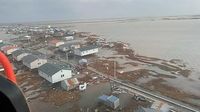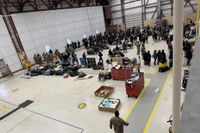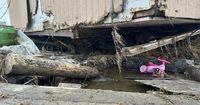When two massive storms—remnants of Typhoon Halong—barreled into western Alaska in mid-October 2025, the region’s remote coastal communities faced devastation on a scale rarely seen. Ferocious hurricane-force winds, record-breaking storm surges, and relentless flooding left more than 1,000 residents displaced, homes destroyed, and infrastructure battered from Kwigillingok to Kotzebue. In the aftermath, a sprawling network of state agencies, tribal organizations, military personnel, and nonprofits swung into action, launching one of Alaska’s largest-ever coordinated disaster relief efforts.
According to the Alaska Division of Homeland Security and Emergency Management, the storm’s wrath was swift and severe. On October 13, an adult woman was found dead in the village of Kwigillingok, a tight-knit community of fewer than 400 people. Search efforts for two missing men from the same village were called off the following day after crews found no trace of them. “We know this is devastating news for the families and loved ones of the two missing people,” said Alaska State Troopers spokesperson Austin McDaniels, promising to reassess if new leads emerged.
For survivors, the ordeal was harrowing. Dozens of residents and two dogs were rescued from both Kwigillingok and neighboring Kipnuk—home to about 700 people—as floodwaters rose rapidly. The National Guard, supported by helicopters and aircraft, airlifted stranded villagers from rooftops, reminiscent of scenes from Hurricane Katrina, as described by US Coast Guard Capt. Christopher Culpepper: “If you imagine the worst-case scenario, that’s what we are dealing with.”
By October 13, more than 1,000 people had been forced from their homes, seeking shelter in schools, community centers, and, as local capacity was exhausted, in emergency shelters in Bethel—the largest city in western Alaska. With Bethel’s facilities stretched thin, officials began relocating evacuees to longer-term housing in Fairbanks and Anchorage. The State Emergency Operations Center (SEOC), led by incident commander Mark Roberts, shifted its focus from immediate life-saving actions to sustaining and sheltering those uprooted by the disaster. “We’ve confirmed that a number of homes cannot be reoccupied, even with emergency repairs, and that infrastructure has been compromised in several communities,” Roberts said. “Our focus now is making sure people are safe, warm, and cared for while we work with our partners to restore essential services.”
The logistics of the response were daunting. The region’s villages are scattered across the vast, roadless Yukon-Kuskokwim Delta, accessible only by boat or small plane—a fact that complicated the delivery of aid and the evacuation of residents. The Alaska National Guard deployed multiple helicopters and a C-17 Globemaster III aircraft to ferry people and supplies. From October 14-15, Black Hawk and Chinook helicopters shuttled evacuees from Kipnuk and Kwigillingok to Bethel. The C-17 transported sanitation supplies, tents, heaters, and food to Bethel and Kotzebue, then returned with about 300 evacuees to Joint Base Elmendorf-Richardson for onward movement to Anchorage shelters. Additional flights continued as hundreds more awaited relocation. “Our Guardsmen, Alaska State Defense Force, and Alaska Naval Militia members are fully engaged across the affected region, conducting evacuations, delivering critical supplies, and helping restore basic services,” said Col. Christen Brewer, AKNG’s Joint Staff operations officer.
The storm’s power was extraordinary. The National Weather Service recorded wind gusts of 107 mph in Kusilvak and 100 mph in Toksook Bay on October 12-13. In Kipnuk, water levels surged to 14.5 feet—more than two feet above major flood stage and shattering the previous record set in 2000. At least eight homes were pushed from their foundations, and critical infrastructure, including the airport in Kipnuk, sustained significant damage. The storm, which began as Typhoon Halong in the northern Philippine Sea, lost its tropical characteristics before entering the Bering Sea but retained its destructive force as it swept through northern Alaska and into the Arctic Sea.
As the disaster unfolded, the human toll mounted. Families faced the loss of homes, schools, and livelihoods. “These families have experienced the worst days of their lives and are now moving away from their homes, schools, and neighbors,” Roberts noted, underscoring the importance of coordinated recovery. The state’s disaster declaration, initially issued for prior storm damage, was expanded by Governor Mike Dunleavy on October 12 to address the latest catastrophe. “Every effort will be made to help those hit by this storm. Help is on the way,” Dunleavy pledged, emphasizing both immediate and long-term support for affected residents.
Federal agencies quickly joined the response. Senator Dan Sullivan reported ongoing communication with Acting FEMA Director David Richardson and other key officials. FEMA deployed an incident management team to Alaska, with a search-and-rescue group on standby in Washington. Despite the government shutdown, Sullivan assured that “the government shutdown is not impacting the agency’s response to this emergency.”
On the ground, local and national nonprofits mobilized to meet urgent needs. The Anchorage-based Alaska Community Foundation partnered with organizations to launch the Western Alaska Disaster Relief 2025 Fund, which had already surpassed $300,000 in donations by October 14. The Alaska Native Heritage Center (ANHC) in Anchorage scheduled a benefit concert on October 18, donating a quarter of proceeds to relief efforts. ANHC also coordinated material aid, financial support for displaced families, and transportation of supplies to Southwest Alaska. Direct Relief, a humanitarian aid group, shipped emergency medical supplies—including field medic packs for triage care outside clinics—and provided $50,000 in emergency response funding. Since 2008, Direct Relief has contributed over $5 million in support to Alaska organizations, responding to disasters such as 2022’s Typhoon Merbok.
Donation drives sprang up across the state. Air cargo companies—Alaska Air Cargo, Everts Air Cargo, Grant Aviation, Lynden Air Cargo, Northern Air Cargo, and Ryan Air—teamed up to fly donated supplies from Anchorage to Bethel, where relief organizations distributed them to affected villages. The Alaska Federation of Natives hosted a major donation drive during its annual convention, while local businesses and organizations, from GCI to Alaska Discount Outfitters, collected goods ranging from water and food to blankets and hygiene products. Even pets were not forgotten: the August Fund for Alaska Racing Dogs sought foster homes for displaced animals, while Straw for Dogs raised money for insulated shelters and straw as winter approached.
As the immediate crisis recedes, the path to recovery will be long and challenging. Hundreds of homes remain uninhabitable, infrastructure repairs are urgent, and many families face months of uncertainty. But the outpouring of support—from state and federal agencies, tribal organizations, the military, and everyday Alaskans—has offered hope amid heartbreak. The collective response, as Col. Brewer put it, is “an all-hands effort, and our commitment is to stay as long as we’re needed.”
For the communities of western Alaska, battered by nature’s fury, the road ahead is daunting. Yet, in the face of disaster, the strength of their neighbors—and the determination of those who have come to help—shines through.


